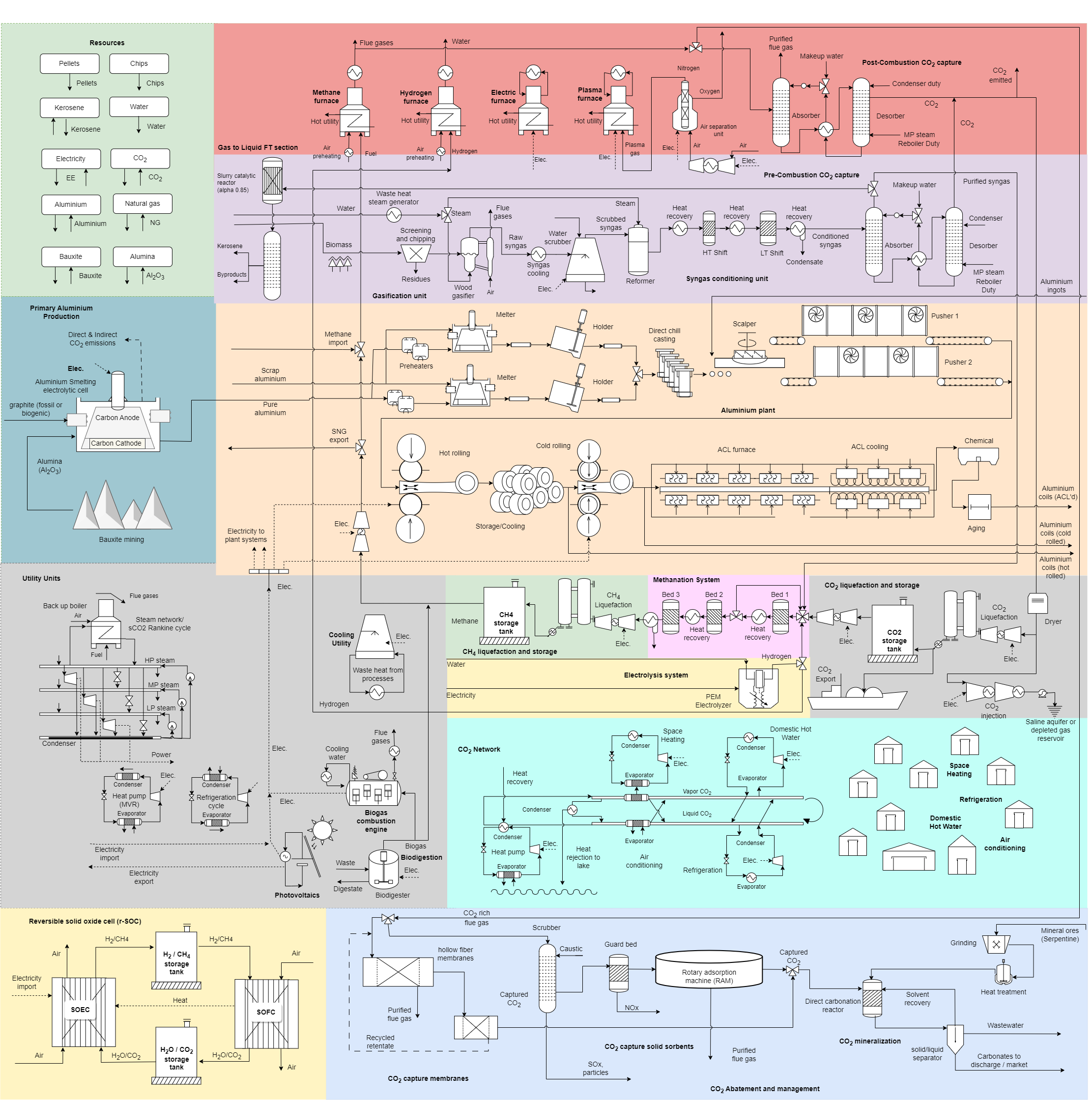Renewable energy integration, waste heat valorization and carbon abatement in an aluminium plant integrated with the energy and urban systems
Summary
This blog provides an introduction into the Net Zero Lab Valais (NZLV) consortium and summarizes key outcomes related to the systemic study evaluating decarbonization options for aluminium production.
Key words: Net Zero, Aluminium production, Decarbonization, Carbon capture, Urban energy systems, Methanol, Olefins, Fischer-Tropsch, CO2 Networks, Gasification, Electrolysis, SNG, Hydrogen, Seasonal storage
Introduction
In February 2022, the Net Zero lab Valais (NZLV) was launched to develop carbon neutral solutions for Aluminium manufacturing at Novelis’s Sierre site. Novelis, OIKEN, HES-SO Valais-Wallis, and EPFL established a research and development laboratory through a collaborative effort with the objective of enabling net zero production at the facility by 2030.
Novelis Inc., signed a long-term collaboration agreement with HES-SO Valais-Wallis in collaboration with EPFL of Energypolis campus, a Swiss innovation and research hub, as well as energy distributor OIKEN, to start a joint research and development (R&D) laboratory to advance carbon neutral solutions for aluminium manufacturing.
The R&D lab, named Net Zero Lab Valais, is located at Novelis’s plant in Sierre, Switzerland. The Sierre site, the broader Valais region and Switzerland itself are an ideal fit for planned initiatives due to the availability of renewable energy sources and strong research institutions, as well as a firm commitment to sustainability. The work of the lab focuses on identifying and implementing innovative solutions to neutralize the carbon footprint of Novelis manufacturing operations and neighbouring communities, starting in Sierre. The aim is to reach carbon neutrality for scope 1 and 2 emissions at the plant by 2030.
In its initial phase, the Net Zero Lab is focusing on identifying decarbonization solutions to launch an ecosystem, by which Novelis, in collaboration with OIKEN, will share the energy from its Sierre plant with the surrounding areas. In other words the heat dissipated from the Aluminium manufacturing process will be put into beneficial use such as district heating. This will help lower the area’s overall carbon footprint, as well as that of the manufacturing site

Systemic study
The systemic analysis for achieving net zero carbon footprint of Novelis plant focuses first on increasing the inherent efficiency of the process units and suitably integrating waste heat within the plant operations as well as prioritizing the use of available resources in the region. Swiss local electricity consumption mix is mainly composed of 66% hydropower and 20% nuclear making electrical solutions an option for lower carbon impact. Alternative methods of energy conversion and reduced carbon footprint may also include carbon capture and utilization, methanation, oxy-combustion, hydrogen production, electrolyzers, combined and organic Rankine cycle, gasification, and others. Plasma torch, magnetic induction, and convection resistance (ceramics) heating processes may also be considered. A schematic of possible solutions under consideration is presented below in Figure 2. Different key performance indicators (KPIs) are used to evaluate the suitability of these technologies including efficiency, CO2 emissions, cost, and technology readiness levels (TRLs). A second goal of the NZLV is to decarbonize Sierre. An anergy network with a working fluid such as CO2 or water could be used for cooling down the hot water that is being currently discarded to the Rhone river. This Anergy network can then be used to run the district heating of the city. Constellium, another aluminium producing facility nearby, may also participate in supplying residual heat for district heating purposes.

List of publications
[1] Flórez-Orrego D, Dardor D, Germanier R, et al. A systemic study for enhanced waste heat recovery and renewable energy integration towards decarbonizing the aluminium industry. In: ECOS 2023 - The 36th international conference on Efficiency, Cost, Optimization, Simulation and environmental impact of energy systems. Las Palmas de Gran Canaria, https://infoscience.epfl.ch/record/303618?ln=en (2023).
[2] Andayesh M, Flórez-Orrego D, Germanier R, et al. Improved Waste Heat Management and Energy Integration in an Aluminum Annealing Continuous Furnace Using a Machine Learning Approach. Entropy 2023; 25: 1486. https://infoscience.epfl.ch/record/306214?ln=en&v=pdf
[3] Dardor D, Flórez-Orrego D, Ribeiro Domingos ME, et al. Decarbonizing the production of primary aluminium using renewable resources. In: Proceedings of the 2023 AIChE Annual Meeting, American Institute of Chemical Engineering. Orlando (FL), United States, https://infoscience.epfl.ch/record/306686?ln=en&v=pdf (2023).
[4] Flórez-Orrego D, Dardor D, Ribeiro Domingos ME, et al. Renewable energy integration and waste heat recovery for the production of sustainable jet fuel and decarbonization of industrial heating applications. In: Proceedings of the 2023 AIChE Annual Meeting, American Institute of Chemical Engineering. Orlando (FL), United States, https://infoscience.epfl.ch/record/306479 (2023).
[5] Flórez-Orrego D, Dardor D, Ribeiro Domingos ME, et al. Renewable energy integration and waste heat Valorization in Aluminum Remelting Mills for the Co-Production of Kerosene and Methanol In: ESCAPE 2024 - 34th European Symposium on Computer Aided Process Engineering. Florence, Italy, https://infoscience.epfl.ch/record/311525 (2024)
[6] Dardor D, Flórez-Orrego D, Ribeiro Domingos, M, et al. CO2 Capture and management strategies for decarbonizing secondary aluminium production. In: ESCAPE 2024 - 34th European Symposium on Computer Aided Process Engineering. Florence, Italy, https://infoscience.epfl.ch/record/311522 (2024).
[7] Flórez-Orrego D, Dardor D, Aimone L, et al. Integration of renewable energy and reversible solid oxide cells towards decarbonizing the secondary aluminium production and urban systems. In: 37th International Conference on Efficiency, Cost, Optimization, Simulation and Environmental Impact of Energy Systems. Rhodes, Greece, 2024.
[8] Dardor D, Flórez-Orrego D, Aimone L, et al. Modelling The effect of future uncertainty in energy prices on decarbonization pathways for secondary aluminium production. In: 37th International Conference on Efficiency, Cost, Optimization, Simulation and Environmental Impact of Energy Systems. Rhodes, Greece, 2024.
[9] Flórez-Orrego D, Dardor D, Ribeiro Domingos, M, et al., Integration of renewable energy and reversible solid oxide cells towards decarbonizing the secondary aluminium production and urban systems. 2024 AIChE Annual Meeting - American Institute of Chemical Engineering. October 27th – 31st, 2024, San Diego, CA, USA.